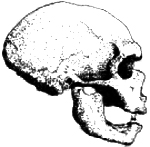2015 Recipient of the Rohlf Medal Medal Announced
The 2015 recipient of the
Rohlf Medal for Excellence in Morphometric Methods and Applications
will be
Benedikt Hallgrímsson
Benedikt Hallgrímsson, Professor of Cell Biology and Anatomy at the University of Calgary, combines developmental genetics with 3D imaging and morphometrics to address the developmental basis and evolutionary significance of phenotypic variation and variability of the mammalian craniofacial complex, with special reference to animal analogues of human craniofacial dysmorphology. His studies combine the quantitative power and detailed anatomical characterization of phenotypic effects that morphometric methods provide with inferences to the developmental processes responsible for those effects.
Recently he has pioneered applications of geometric morphometrics to large samples of embryos, potentially rendering high-throughput morphometric analysis a tool just as relevant to medicine as to developmental biology or morphometrics. That geometric morphometrics is now widely accepted as a technique in developmental biology is largely due to Hallgrimsson's work in his laboratory and in his role as editor of the journal Evolutionary Biology. For his excellence in evo-devo morphometric research, for his advances in the imaging technology that drives the research, and for his varied and energetic efforts at disseminating all this to a broad variety of audiences, Benedikt Hallgrimsson richly deserves the honor of this third Rohlf Medal for Excellence in Morphometrics.
The medal will be presented on October 26, 2015 at Stony Brook University. Afterwards, he will present a lecture on "Morphometrics and the Middle-Out Approach to Complex Traits".
Abstract: How development translates genetic into phenotypic variation is one of the hardest questions in biology. This issue is central to understanding how selection acting on phenotypic variation produces evolutionary change. It is also a key challenge that must be overcome to enable precision medicine for structural birth defects. I study the genetic, developmental and environmental determinants of variation in craniofacial and skeletal form. To do this, my collaborators and I blend morphometrics and advanced imaging with developmental biology and genetics. Our approach is to create and analyze large sets of 3D image data from animal models and humans to study how genes relate to variation in facial shape. This allows us to identify patterns of variation that correspond to particular developmental mechanisms or genetic pathways. We then manipulate those mechanisms experimentally in animal models in order to determine how they generate variation in the facial form including birth defects. Finally, we apply our understanding of facial genetics and development to determine how disruption of growth, either by nutrition or syndromes influences facial shape. This approach is innovative because, rather than focusing on individual genes, we focus on pathways or processes that correspond to the effects of many genes on the development of the face. In this way, we break down the complexity of the genetics of complex traits such as facial shape. This results in explanations of variation that have significant implications for how organismal form evolves. Our hope is that such "middle-out" explanations will eventually also help inform individualized treatment for patients.
The full announcement is available on the Stony Brook University website.
